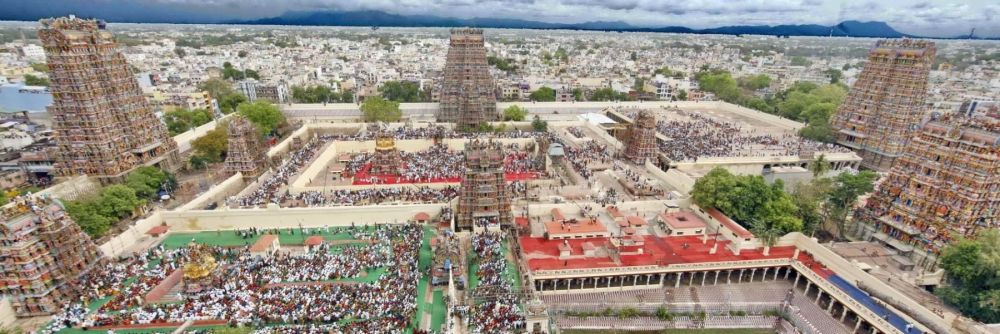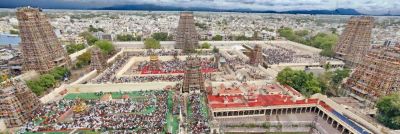

The Meenakshi Amman Temple is an ancient and one of the most important landmarks in Madurai. This temple is a significant symbol for the Tamil people and has been mentioned in texts dating back to the 6th century. The temple is dedicated to Goddess Meenakshi, a form of Parvati, and her consort Lord Sundareshwar, a form of Shiva. Visitors are greeted by towering gopurams (gateway towers), adorned with thousands of colorful and finely sculpted figures. The temple complex is a sprawling city within a city and features detailed carvings, grand pillared halls, and holy sanctums. One is sure to be awed by the architectural brilliance and the vibrant atmosphere during a visit, which is further enhanced by the rituals and ceremonies conducted daily. Exploring the entire complex and absorbing its history and spiritual significance usually takes about 1 to 2 hours.
The Gandhi Memorial Museum in Madurai is one of the five Gandhi Sangrahalayas (Museums) in India. Founded in 1959, the museum is located in the historical Tamukkam Palace and is devoted to the life and legacy of Mahatma Gandhi. The highlights of the museum include the ‘India Fights for Freedom’ exhibition which displays detailed accounts of the freedom struggle and a special section that houses relics of Gandhi's bloodstained garment from the day of his assassination. The museum provides an insightful look into the history of Indian independence and Gandhi's role in it. Visitors will also find a library, a bookshop selling literature on Gandhi, and a gallery showcasing South Indian village industries. Spending 1 to 1.5 hours here is usually enough to thoroughly explore the museum.
The Tirumalai Nayak Palace is a 17th-century palace erected by King Tirumalai Nayak, who played a significant role in the construction of several of Madurai's buildings. This grand palace is a classic fusion of Dravidian and Rajput styles, featuring massive white columns and an imposing courtyard. The palace has undergone numerous restorations and still stands as a testimony to the architectural prowess of the Nayak Dynasty. Daily sound and light shows in the evening beautifully narrate the history of Tirumalai Nayak and the city of Madurai. Inside, visitors can explore the museum showcasing the royal remnants, the king's throne, and other artifacts. One can enjoy about an hour-long visit to this palace, taking in the history and architectural details.
Situated around 20 km north of Madurai, Alagar Koil (also known as Azhagar Kovil) is a prominent Vishnu temple located in the serene foothills of the Alagar hills. The temple is dedicated to Lord Kallazhagar, a manifestation of Vishnu, and boasts striking Dravidian architecture with beautiful carvings and sculptures. The temple complex houses several mandapams (pillared halls) and prakarams (enclosures). Visitors can also enjoy the abundant natural beauty surrounding the temple, including the forested areas and nearby streams. Visiting the temple and the surrounding areas generally takes around 2 to 3 hours, and it is recommended to attend the vibrant Chithirai Festival if one is visiting in April-May.
Thirupparamkunram Murugan Temple is one of the six abodes of Lord Murugan and lies approximately 8 km south of Madurai. The temple is carved out of a rocky hill and provides a mystical and ancient aura for visitors. Pilgrims and tourists alike can admire the rock-cut architecture and significant historical and religious significance of the temple. The deity Lord Murugan is revered in the form of a peacock, showcasing the local lore and traditions. It is a blissful and calming experience to walk through the temple's corridors and explore the intricately painted scenes from Hindu mythology. The visit could take about an hour or more, especially if one wishes to participate in any of the daily rituals or take the time to meditate.
Puthu Mandapam is an age-old pillared hall situated right outside the Meenakshi Temple's eastern gate. It was originally built for temple functions but is today a thriving market where you can find an assortment of items, ranging from fabrics, tailoring shops, and jewelry to traditional handicrafts and souvenirs. This provides shoppers with a unique experience as they get to witness the blend of culture, history, and commerce all under one roof. The stone-carved columns and the ceiling painted with mythical figures add to the charm of shopping here. Usually, visitors spend from 30 minutes to an hour here, but those with a keen interest in shopping may stay longer.
St. Mary's Cathedral Madurai stands out with its striking European and Continental architectural styles. It is one of the oldest Roman Catholic churches in India, and its beautiful facade and imposing twin towers are remarkable. Inside the cathedral, visitors can admire the beautiful stained glass, paintings, and rituals that provide a serene sanctuary. St. Mary's is more than just a place of worship; it's a piece of art that demonstrates the confluence of different cultural heritages in Madurai. A visit to the cathedral is usually brief, lasting about 30 minutes to an hour, but is sure to leave visitors in awe of its beauty and tranquility.
The Samanar Hills, or Samanar Malai, is an important historical and archaeological site located 10 km away from Madurai. This site is famous for its ancient Jain carvings dated to the 1st century A.D. Visitors can embark on a short trek up the hill to see the carvings, caves, and inscriptions that demonstrate the history of the Jain monks who lived here thousands of years ago. The hilltop also offers panoramic views of the surrounding landscape, which makes for a picturesque and educational outing. A typical visit involves moderate hiking and can last for about 2 to 2.5 hours, inclusive of the time spent exploring and enjoying the views.
Vandiyur Mariamman Teppakulam is a massive square water tank located about 5 km away from the Meenakshi Amman Temple. The tank is associated with the temple and is the site of the famous Teppakulam float festival, which occurs in January/February. The tank's center houses a temple dedicated to Lord Vigneshwara (Vinayaka), which is accessible during the festival when the tank is filled with water. Visitors can enjoy the tranquility of the site and admire the architecture and the craftsmanship of the sculptures. A normal visit here is a leisurely one, typically lasting about 1 hour to take in the sights and the peaceful atmosphere.
The Kazimar Big Mosque, located in the heart of Madurai, is the city's first mosque, built in the 13th century by Hazrat Kazi Syed Tajuddin, who came from Oman and settled in Madurai. The mosque is also home to the Maqbara (burial place) of the Madurai Hazrats, descendants of Islamic prophet Muhammad. Visitors can experience the calm and spirituality of the mosque, which showcases Islamic architecture and the rich cultural heritage of the region's Muslims. Understanding the mosque's history and witnessing the daily prayers typically requires a visit of about 1 hour. Note that non-Muslim visitors may have restrictions on entering certain areas of the mosque.
